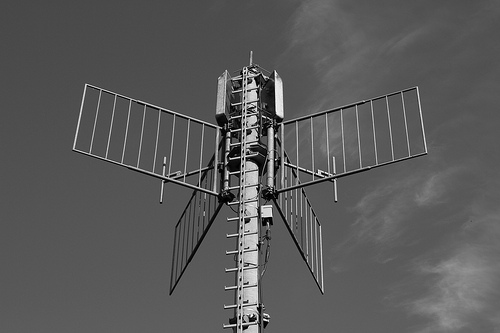Google and Microsoft are sniffing around white spaces spectrum in the U.K., according to a Telegraph report, with a view to possibly offering free built-in WiFi for mobile devices running their software. The paper does not have explicit details of the pair’s plans but rather quotes government sources saying the two companies have expressed “extreme interest” in the unused airwaves and “clearly see it [white spaces spectrum] as very, very important. They have shown extreme interest in this as a way of getting closer to customers and offering something different to Apple”.
Google told TechCrunch it does not have a comment on the story. We’ve also reached out to Microsoft and will update with any response. If true, it’s not the first time Google (or Microsoft) has shown an interest in spectrum. Back in 2008, Google bid on the 700MHz spectrum auction in the U.S. (losing out to Verizon). Last year Microsoft also joined a consortium of companies running a trial of white spaces spectrum in the U.K. — looking at whether it could be used to create citywide wi-fi networks.
White spaces spectrum refers to spectrum that lies unused within spectrum bands, left fallow to create gaps or buffers between TV broadcasts to avoid interference between channels. In the U.K. various uses have been proposed for this spectrum — telecoms regulator Ofcom has been pushing the idea of making use of white spaces for more than a year, noting in a release last year the spectrum could be suitable for
Enhanced Wi-Fi: The majority of current Wi-Fi devices operate in spectrum at 2.4GHz. White Spaces could provide new capacity, while boosting the range of devices, potentially enabling Wi-Fi networks that stretch across towns and cities. This is thanks to the lower frequency of TV White Spaces (typically between 470 and 790MHz).
Rural broadband: White Spaces could be used to provide rural locations with broadband services. In practice, this could be achieved by building a network of transmitters that use White Spaces to link remote houses and villages to larger towns that are already connected to the internet. Trials are currently being undertaken by industry to test this on the island of Bute, Scotland.
Machine-to-Machine Communications: A relatively new area of innovation called Machine-to-Machine Communications allows information to be exchanged between devices. Many experts believe that in the coming years billions of devices will be able to connect wirelessly and via the internet for a range of applications. White spaces could be used to wirelessly transmit this information, using its additional range to reach deep inside buildings. This could be especially useful for wirelessly measuring utility meters in consumers’ homes – just one of a wide number of potential applications. Other examples include using White Spaces to keep an inventory of stock owned by a business, or making it easier for scientists to conduct research by automating the measurement of different readings.
Unlike spectrum auctioned to run 2G, 3G and 4G services, Ofcom wants the white spaces spectrum to be licence exempt — which means anyone would be able to operate in the spectrum without having to first shell out for a licence to run their service. The only condition Ofcom would place is that those using the spectrum “do not cause harmful interference to existing users of the spectrum”.
Ofcom has been consulting on white spaces spectrum since the beginning of the year, and expects to publish an update on progress before the year is out. The technology could be launched in the UK next year — “possibly towards the end of 2013” according to a spokesman — though the regulator also notes it needs to consult on licence exemption for white space devices (so that device makers do not have to license every piece of hardware they make), and draft new legislation to confirm the licence-exempt status for white spaces spectrum.
Here’s Ofcom’s explanation of how a licence-exempt white spaces spectrum market would operate in the U.K.
White Space technology will work in a similar way to Wi-Fi, which uses a wireless router to send and receive information to other wireless devices. The main difference is that the White Space router – or “master” device as it is known technically – will first need to consult a list of databases hosted online. It will notify one of these databases of its location and update it on a regular basis. The database will then return details of the radio-frequencies and power levels it is allowed to use. This will ensure that the devices do not interfere with existing licensed users of the spectrum, which include Digital Terrestrial Television and wireless microphone users.
Ofcom has decided to allow multiple third-party providers to develop databases, which will create a competitive marketplace and incentivise operators to provide the best database service to consumers.
Bearing all that in mind, it’s difficult to see how the Telegraph’s claim that: “Google and Microsoft are expected to launch a major charm offensive to win control of the valuable airwaves” stands up — since Ofcom is not planning to auction the spectrum off to a select few.
The newspaper goes on to speculate that Google and Microsoft “could also use the white spaces to provide widespread broadband access, potentially giving them an important calling card with which to win over customers” — so, at a push, it’s possible the pair are lobbying the U.K. government for an alternative to Ofcom’s preferred path. Perhaps making a case for the spectrum being auctioned off in exchange for rural broadband coverage pledges.
